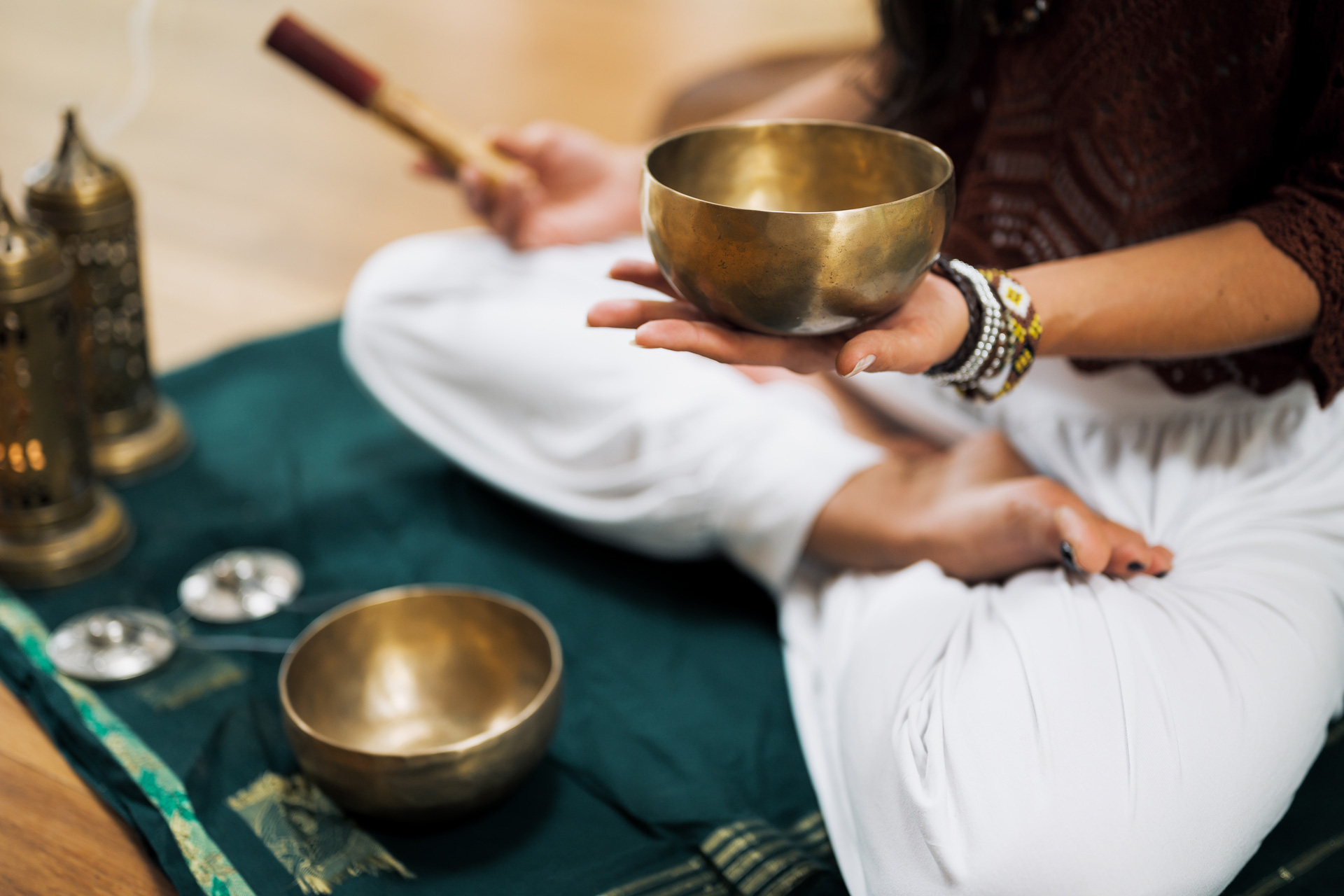Vedic Sound Healing: A Guide
By
2 years ago
This sound therapy experience is renowned for its wellness benefits

Whether it’s a soothing playlist or a sleep-inducing meditation, no doubt we’ve all felt the benefits of sound healing at some stage in our lives. Sound is a powerful tool: it can alter our mood and relax our nervous system – hence why more and more of us are turning to sound therapies to help relieve stress. Gong baths, for instance, have made their way into the mainstream. But have you tried Vedic sound healing? The ancient Indian practice uses music and vibrations to send our bodies into a state of deep relaxation, using a process called energy entrainment. We spoke to Vedic sound healer Nevita to find out more.
Vedic Sound Healing: A Guide
What is Vedic sound healing?
Rooted in ancient Indian Vedic traditions, Vedic sound healing is a unique approach to self-discovery and wellbeing using sound frequencies, mantras and vibrations to restore balance, promote healing, and facilitate spiritual growth. By incorporating ancient wisdom, sacred sounds and mantras, it provides a unique opportunity to experience deep relaxation, cultivate mindfulness and foster spiritual growth.
The human body is made of seven different energy centres, known as chakras. Each chakra corresponds to a particular sound frequency that, when stimulated, helps balance and unblock the flow of energy throughout the body. When these frequencies deviate from their natural state, for example during times of stress, it causes cellular changes, disrupting the body’s fluid energy flow. This disruption can lead to mental wellbeing issues, physical ailments and even disease. Vedic sound healing aligns these chakras to support physical, emotional and spiritual well-being.

Where does the practice traditionally come from?
The Vedas, ancient Indian texts in Sanskrit, form the basis of Vedic sound healing. These sacred scriptures cover various aspects of life, including spirituality, philosophy, and healing practices. Central to Vedic sound healing is the concept of ‘Nada Brahma,’ meaning ‘the world is sound.’ This idea emphasises the interconnectedness of all things through vibrations and frequencies, paving the way for using sound as a powerful healing tool.
How does it work?
Vedic sound healing uses musical and vocal vibrations to influence and rectify the body’s vibrations through a process known as energy entrainment. Entrainment is the natural process of a rhythmic pattern, which stimulates other systems to fall into the same rhythm. Vedic sound healing operates on the principle of entrainment. For example, when we hear music, we tap our feet to the rhythm. In sound healing, it is used to entrain brainwaves to a slower rhythm, to help bring about a state of deep relaxation where it can realign its frequencies and return to its natural state of harmony.
What makes Vedic sound healing different to other forms of sound healing?
- Use of sacred mantras: Vedic sound healing often incorporates mantras (sacred syllables or phrases) derived from the Vedic scriptures. These mantras are considered to carry powerful energetic vibrations and are believed to have specific healing properties.
- Emphasis on Sanskrit: The language used in the Vedas is Sanskrit, a language believed to be vibrational in nature. The sounds and chants used in Vedic sound healing, often derived from Sanskrit words, are thought to resonate with the body’s energy centres, or chakras, to promote healing and balance.
- Spiritual and philosophical context: Vedic sound healing is not just about the physical and mental aspects of healing, but also has a strong spiritual and philosophical component. It is seen as a way to align oneself with the cosmos and attain higher states of consciousness. Many participants have shared that Vedic sound healing leads to unique experiences. They often describe feeling as if they’ve been taken to a different level of consciousness beyond their normal understanding. This suggests that the practice can help people connect deeply with themselves and the wider universe.
- Use of specific instruments: While many sound healing practices use tools like singing bowls and gongs, Vedic sound healing also includes traditional Indian instruments like the harmonium, shruti and others known for their resonating and healing frequencies. The shruti is used predominantly in my sessions and I lovingly describe it as the strings of my heart.
How did you get into it?
Singing was always a big part of my childhood, so much so that I pursued my passion for music by studying at the Academy of Contemporary Music in Johannesburg, South Africa.
Growing up my mother and my family were also devoted to Hindu rituals, such as prayer, temple visits, and fasting during sacred traditions. My mom encouraged me to pray daily before school, which I did without truly understanding why. It wasn’t until I lived in an Ashram in Malavli that I gained a deep appreciation for the philosophy behind these rituals.
In the ashram, I was introduced to chants, devotional music and sacred prayers. Hindus have many gods, each embodying noble virtues and values essential for life. These gods teach us lessons and inspire us to lead happier lives. The devotional music I learned honoured gods like Krishna, Shiva, and Vishnu, directing my love toward something greater, beyond and within me. The feeling that comes from this connection is beyond words.
The chants I learned were from the Upanishads and the Bhagavad Gita, ancient Indian scriptures that serve as life manuals, much like the Bible or Quran. The prayers were not about asking for things, but expressing gratitude for everything we already have.
These chants, devotional songs and prayers form the core of Vedic sound healing sessions, lifting the spirits of anyone open to embracing their deep messages and vibrations. After moving to London, I lost touch with these practices for a while. But one day, my husband gifted me a beautiful shruti (Indian harmonium), rekindling my connection with these sacred sounds. Since then, I’ve never looked back, and I’m thrilled to share the power and beauty of Vedic sound healing.

What are the health benefits?
Altering the vibration and energetic state of a person through sound healing offers a multitude of emotional, mental, physical, energetic and spiritual health benefits including:
- Physical healing: reduces inflammation, boosts the immune system and relaxes tissues.
- Mental healing: promotes relaxation, reduces stress and anxiety by removing blockages and restoring balance and also increases energy to improve mental clarity and focus.
- Emotional healing: sound evokes feeling and Vedic sound healing can bring emotions to the surface to help with emotional processing.
- Energetic healing: Vedic sound healing is used to align the seven chakras (or energy centres) of the body helping to balance and unblock the flow of energy throughout the body so it can move freely.
- Spiritual healing: sound healing encourages our thoughts and conditionings to dissipate into a dream-like nothingness, opening up the space to access expanded states of consciousness, connecting us to truth, bliss and peace within.
How can people expect to feel afterwards?
After immersing yourself in the soothing sounds of the shruti (Indian harmonium instrument), healing vocal tones and devotional music, paired with a unique blend of breathwork, meditation and affirmations, Vedic sound healing will leave you feeling energetically balanced, emotionally liberated, less stressed and more relaxed. You’ll also feel more connected to your heart and spirit, and have more clarity, confidence and inner peace around your values and what’s important to you. My sessions also help to revitalise energy, to dismantle harmful conditioning, to help reprogramme neural pathways, process and release emotional trauma.
Who is it suitable for? Is there anyone who shouldn’t try it?
Vedic sound healing is generally suitable for most people as it’s a non-invasive practice focused on relaxation and balance. It can be an option for those seeking alternative or complementary therapeutic modalities, including individuals who:
- Are looking for ways to reduce stress and anxiety
- Want to improve their focus and mental clarity
- Are interested in exploring meditation and mindfulness techniques
- Seek to increase self-awareness and personal growth
- Want to enhance their overall well-being and sense of inner peace
However, like any therapeutic practice, there can be certain situations or conditions where caution is advised. While Vedic sound healing is typically safe, individuals in the following scenarios should consult a healthcare provider before participating:
- Those with certain mental health conditions, such as psychosis or severe personality disorders, who may have difficulty processing or integrating the experiences that can occur during sound healing sessions.
- People with specific sound or vibration sensitivities, including certain neurological conditions like epilepsy.
- Those with a history of trauma or PTSD. While many find sound healing therapeutic, the deep relaxation it promotes could potentially trigger unwanted memories or reactions.
- People with hearing impairments or conditions like tinnitus may want to seek advice from a healthcare provider to ensure that the sounds used in therapy will not exacerbate their condition.
It’s always advisable to approach any new therapy or practice with mindfulness and caution, listen to your body, and consult with a trusted healthcare provider as needed.
Find out more at nevita.co.uk









